Neurocognitive mechanisms of conceptual processing in healthy adults and patients with schizophrenia
- PMID: 20004221
- PMCID: PMC2842912
- DOI: 10.1016/j.ijpsycho.2009.12.002
Neurocognitive mechanisms of conceptual processing in healthy adults and patients with schizophrenia
Abstract
This overview outlines findings of cognitive and neurocognitive studies on comprehension of verbal, pictorial, and video stimuli in healthy participants and patients with schizophrenia. We present evidence for a distinction between two complementary neurocognitive streams of conceptual analysis during comprehension. In familiar situations, adequate understanding of events may be achieved by mapping the perceived information on the associative and similarity-based connections between concepts in semantic memory - a process reflected by an N400 waveform of event-related electrophysiological potentials (ERPs). However, in less conventional contexts, a more flexible mechanism may be needed. We suggest that this alternative processing stream, reflected by a P600 ERP waveform, may use discrete, rule-like goal-related requirements of real-world actions to comprehend relationships between perceived people, objects, and actions. This neurocognitive model of comprehension is used as a basis in discussing studies in schizophrenia. These studies suggest an imbalanced engagement of the two conceptual streams in schizophrenia, whereby patients may rely on the associative and similarity-based networks in semantic memory even when it would be more adaptive to recruit mechanisms that draw upon goal-related requirements. Finally, we consider the roles that these conceptual mechanisms may play in real-life behavior, and the consequences that their dysfunction may have for disorganized behavior and inability to plan actions to achieve behavioral goals in schizophrenia.
Copyright 2009 Elsevier B.V. All rights reserved.
Figures










Similar articles
-
Neurocognitive abnormalities during comprehension of real-world goal-directed behaviors in schizophrenia.J Abnorm Psychol. 2009 May;118(2):256-77. doi: 10.1037/a0015619. J Abnorm Psychol. 2009. PMID: 19413402 Free PMC article.
-
Two neurocognitive mechanisms of semantic integration during the comprehension of visual real-world events.J Cogn Neurosci. 2008 Nov;20(11):2037-57. doi: 10.1162/jocn.2008.20143. J Cogn Neurosci. 2008. PMID: 18416681 Free PMC article.
-
Semantic and syntactic processes during sentence comprehension in patients with schizophrenia: evidence from event-related potentials.Schizophr Res. 2003 Nov 15;64(2-3):147-56. doi: 10.1016/s0920-9964(02)00482-6. Schizophr Res. 2003. PMID: 14613679
-
The N400 event-related brain potential response: A window on deficits in predicting meaning in schizophrenia.Int J Psychophysiol. 2019 Nov;145:65-69. doi: 10.1016/j.ijpsycho.2019.04.005. Epub 2019 Apr 30. Int J Psychophysiol. 2019. PMID: 31047943 Review.
-
Neural mechanisms of language comprehension: challenges to syntax.Brain Res. 2007 May 18;1146:23-49. doi: 10.1016/j.brainres.2006.12.063. Epub 2006 Dec 23. Brain Res. 2007. PMID: 17400197 Review.
Cited by
-
Is black always the opposite of white? An investigation on the comprehension of antonyms in people with schizophrenia and in healthy participants.Behav Sci (Basel). 2015 Mar 9;5(1):93-112. doi: 10.3390/bs5010093. Behav Sci (Basel). 2015. PMID: 25760930 Free PMC article.
-
Electrophysiological potentials reveal cortical mechanisms for mental imagery, mental simulation, and grounded (embodied) cognition.Front Psychol. 2012 Sep 14;3:329. doi: 10.3389/fpsyg.2012.00329. eCollection 2012. Front Psychol. 2012. PMID: 23049515 Free PMC article.
-
Top-down modulation of visual processing and knowledge after 250 ms supports object constancy of category decisions.Front Psychol. 2015 Sep 16;6:1289. doi: 10.3389/fpsyg.2015.01289. eCollection 2015. Front Psychol. 2015. PMID: 26441701 Free PMC article.
-
Brain Responses at Encoding Predict Limited Verbal Memory Retrieval by Persons with Schizophrenia.Arch Clin Neuropsychol. 2018 Jun 1;33(4):477-490. doi: 10.1093/arclin/acx082. Arch Clin Neuropsychol. 2018. PMID: 28961775 Free PMC article.
References
-
- Aloia MS, Gourovitch ML, Weinberger DR, Goldberg TE. An investigation of semantic space in patients with schizophrenia. J Int Neuropsychol Soc. 1996;2(4):267–273. - PubMed
-
- American_Psychiatric_Association. Diagnostic and statistical manual of mental disorders. Washington, DC: Author; 1994.
-
- Andreasen NC. Scale for the Assessment of Negative Symptoms (SANS) Iowa City, IA: Univ. Iowa; 1984a. - PubMed
-
- Andreasen NC. Scale for the Assessment of Positive Symptoms (SAPS) Iowa City, IA: Univ. Iowa; 1984b.
Publication types
MeSH terms
Grants and funding
LinkOut - more resources
Full Text Sources
Medical

